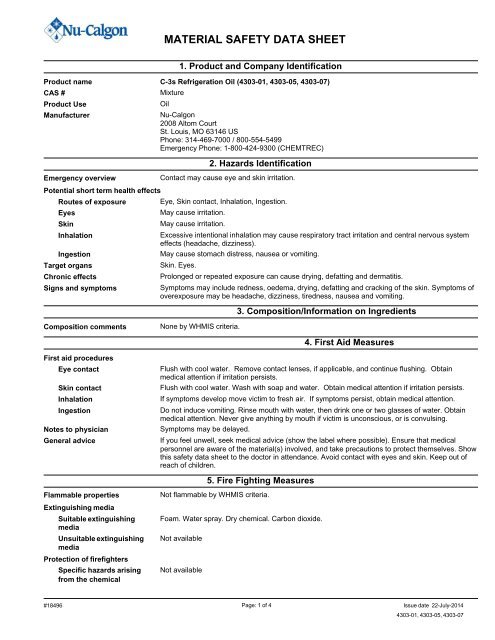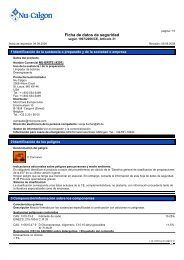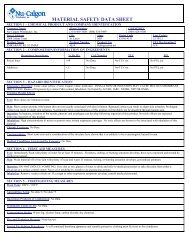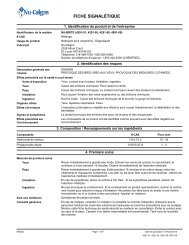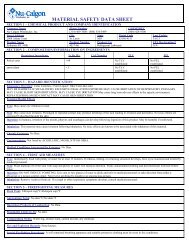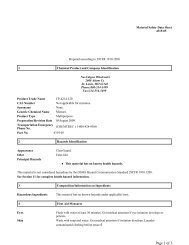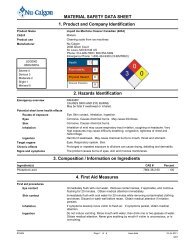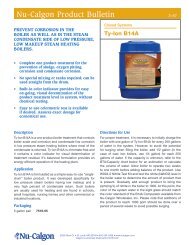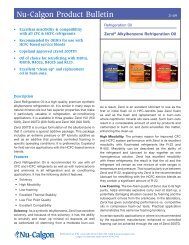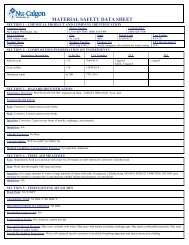C-3s Refrigeration Oil - 4303 - Nu-Calgon
C-3s Refrigeration Oil - 4303 - Nu-Calgon
C-3s Refrigeration Oil - 4303 - Nu-Calgon
- No tags were found...
You also want an ePaper? Increase the reach of your titles
YUMPU automatically turns print PDFs into web optimized ePapers that Google loves.
MATERIAL SAFETY DATA SHEET1. Product and Company IdentificationProduct name C-<strong>3s</strong> <strong>Refrigeration</strong> <strong>Oil</strong> (<strong>4303</strong>-01, <strong>4303</strong>-05, <strong>4303</strong>-07)CAS #MixtureProduct Use<strong>Oil</strong>Manufacturer<strong>Nu</strong>-<strong>Calgon</strong>2008 Altom CourtSt. Louis, MO 63146 USPhone: 314-469-7000 / 800-554-5499Emergency Phone: 1-800-424-9300 (CHEMTREC)2. Hazards IdentificationEmergency overviewContact may cause eye and skin irritation.Potential short term health effectsRoutes of exposure Eye, Skin contact, Inhalation, Ingestion.EyesMay cause irritation.SkinMay cause irritation.InhalationExcessive intentional inhalation may cause respiratory tract irritation and central nervous systemeffects (headache, dizziness).IngestionMay cause stomach distress, nausea or vomiting.Target organsSkin. Eyes.Chronic effectsProlonged or repeated exposure can cause drying, defatting and dermatitis.Signs and symptomsSymptoms may include redness, oedema, drying, defatting and cracking of the skin. Symptoms ofoverexposure may be headache, dizziness, tiredness, nausea and vomiting.3. Composition/Information on IngredientsComposition commentsNone by WHMIS criteria.4. First Aid MeasuresFirst aid proceduresEye contactSkin contactInhalationIngestionNotes to physicianGeneral adviceFlush with cool water. Remove contact lenses, if applicable, and continue flushing. Obtainmedical attention if irritation persists.Flush with cool water. Wash with soap and water. Obtain medical attention if irritation persists.If symptoms develop move victim to fresh air. If symptoms persist, obtain medical attention.Do not induce vomiting. Rinse mouth with water, then drink one or two glasses of water. Obtainmedical attention. Never give anything by mouth if victim is unconscious, or is convulsing.Symptoms may be delayed.If you feel unwell, seek medical advice (show the label where possible). Ensure that medicalpersonnel are aware of the material(s) involved, and take precautions to protect themselves. Showthis safety data sheet to the doctor in attendance. Avoid contact with eyes and skin. Keep out ofreach of children.5. Fire Fighting MeasuresFlammable propertiesExtinguishing mediaSuitable extinguishingmediaUnsuitable extinguishingmediaProtection of firefightersSpecific hazards arisingfrom the chemicalNot flammable by WHMIS criteria.Foam. Water spray. Dry chemical. Carbon dioxide.Not availableNot available#18496 Page: 1 of 4 Issue date 22-July-2014<strong>4303</strong>-01, <strong>4303</strong>-05, <strong>4303</strong>-07
Protective equipment forfirefightersHazardous combustionproductsExplosion dataSensitivity to mechanicalimpactSensitivity to staticdischargeFirefighters should wear full protective clothing including self contained breathing apparatus.May include and are not limited to: Oxides of carbon.Not available.Not available.6. Accidental Release MeasuresPersonal precautionsEnvironmental precautionsMethods for containmentMethods for cleaning upKeep unnecessary personnel away. Do not touch or walk through spilled material. Do not touchdamaged containers or spilled material unless wearing appropriate protective clothing. Keeppeople away from and upwind of spill/leak.Do not discharge into lakes, streams, ponds or public waters.Stop leak if you can do so without risk. Prevent entry into waterways, sewers, basements orconfined areas.Before attempting clean up, refer to hazard data given above. Small spills may be absorbed withnon-reactive absorbent and placed in suitable, covered, labelled containers. Prevent large spillsfrom entering sewers or waterways. Contact emergency services and supplier for advice. Neverreturn spills to original containers for re-use.7. Handling and StorageHandlingStorageEnsure adequate ventilation.Avoid contact with eyes, skin and clothing.Use good industrial hygiene practices in handling this material.When using do not eat or drink.Wash hands before breaks and immediately after handling the product.Keep out of reach of children.Store in a closed container away from incompatible materials.8. Exposure Controls/Personal ProtectionExposure limitsEngineering controlsPersonal protective equipmentEye/Face protectionHand protectionSkin and body protectionRespiratory protectionGeneral hygieneconsiderationsNot applicable.General ventilation normally adequate.Wear safety glasses with side shields.Rubber gloves. Confirm with a reputable supplier first.As required by employer code.Where exposure guideline levels may be exceeded, use an approved NIOSH respirator. Avoidbreathing mists or vapours.Handle in accordance with good industrial hygiene and safety practices.When using do not eat or drink.Wash hands before breaks and immediately after handling the product.9. Physical and Chemical PropertiesAppearanceColourFormOdourOdour thresholdPhysical statepHFreezing pointBoiling pointPour pointEvaporation rateFlash pointClearStraw coloredLiquidMild petroleumNot available.Liquid.Not availableNot available.> 260 °C (> 500 °F)Not available.Not available165.6 °C (330.0 °F)#18496 Page: 2 of 4 Issue date 22-July-2014<strong>4303</strong>-01, <strong>4303</strong>-05, <strong>4303</strong>-07
Auto-ignition temperature 343 °C (649.4 °F)Flammability Limits in Air, Not availableUpper, % by VolumeFlammability Limits in Air, Not availableLower, % by VolumeHeat of combustionNot available.Vapour pressure < 0 mmHg @ 20°CVapour density > 5Specific gravity 0.9129Partition coefficientNot available(n-octanol/water)Solubility (Water)NegligibleRelative densityNot available.Viscosity 157.2VOCNot availablePercent volatileNot available10. Stability and ReactivityReactivityPossibility of hazardousreactionsChemical stabilityConditions to avoidIncompatible materialsHazardous decompositionproductsThis product may react with oxidizing agents.Hazardous polymerisation does not occur.Stable under recommended storage conditions.Do not mix with other chemicals.Oxidizers.May include and are not limited to: Oxides of carbon.11. Toxicological InformationEffects of acute exposureEye contactMay cause irritation.Skin contactMay cause irritation.InhalationExcessive intentional inhalation may cause respiratory tract irritation and central nervous systemeffects (headache, dizziness).IngestionMay cause stomach distress, nausea or vomiting.SensitisationNon-hazardous by WHMIS criteria.Chronic effectsNon-hazardous by WHMIS criteria.CarcinogenicityNon-hazardous by WHMIS criteria.MutagenicityNon-hazardous by WHMIS criteria.Reproductive effects Non-hazardous by WHMIS criteria.TeratogenicityNon-hazardous by WHMIS criteria.Name of Toxicologically Not available.Synergistic Products12. Ecological InformationEcotoxicityPersistence and degradabilityBioaccumulation/accumulationMobility in environmentalmediaEnvironmental effectsAquatic toxicityPartition coefficientComponents of this product are hazardous to aquatic life.Not available.Not availableNot available.Not available.Not available.Not available.#18496 Page: 3 of 4 Issue date 22-July-2014<strong>4303</strong>-01, <strong>4303</strong>-05, <strong>4303</strong>-07
Chemical fate informationNot available.13. Disposal ConsiderationsDisposal instructionsWaste from residues / unusedproductsContaminated packagingDispose in accordance with all applicable regulations.Not availableNot available14. Transport InformationTransportation of Dangerous Goods (TDG - Canada)Not regulated as dangerous goods.15. Regulatory InformationCanadian federal regulationsWHMIS statusThis product has been classified in accordance with the hazard criteria of the Controlled ProductsRegulations and the MSDS contains all the information required by the Controlled ProductsRegulations.Not ControlledInventory statusCountry(s) or region Inventory Name On Inventory (Yes/No)*CanadaDomestic Substances List (DSL)YesCanadaNon-Domestic Substances List (NDSL)No*A "Yes" indicates that all components of this product comply with the inventory requirements administered by the governing country(s)LEGENDSevere 4Serious 3Moderate 2Slight 1Minimal 0HEALTH / 1FLAMMABILITY 1PHYSICAL HAZARD 0PERSONALPROTECTION16. Other InformationX11 0DisclaimerInformation contained herein was obtained from sources considered technically accurate andreliable. While every effort has been made to ensure full disclosure of product hazards, in somecases data is not available and is so stated. Since conditions of actual product use are beyondcontrol of the supplier, it is assumed that users of this material have been fully trained according tothe requirements of all applicable legislation and regulatory instruments. No warranty, expressedor implied, is made and supplier will not be liable for any losses, injuries or consequential damageswhich may result from the use of or reliance on any information contained in this document.Issue date22-July-2014Effective date15-July-2014Expiry Date15-July-2017Prepared by <strong>Nu</strong>-<strong>Calgon</strong> Technical Service Phone: (314) 469-7000Other informationFor an updated MSDS, please contact the supplier/manufacturer listed on the first page of thedocument.This MSDS conforms to the ANSI Z400.1/Z129.1-2010 Standard.#18496 Page: 4 of 4 Issue date 22-July-2014<strong>4303</strong>-01, <strong>4303</strong>-05, <strong>4303</strong>-07


